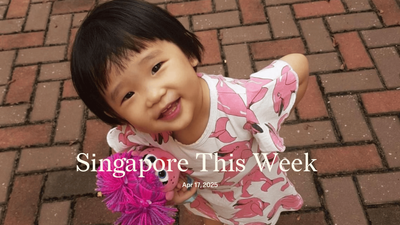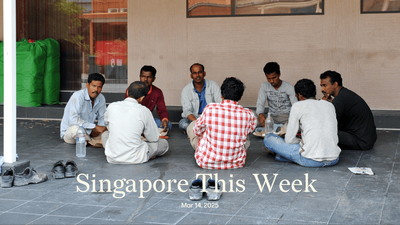Politics: Your birthday angpao before you vote
“Something for everyone”, said The Straits Times (ST), The Business Times, and the South China Morning Post. “Big buffet” and “panoramic in scope”, gushed Vikram Khanna, the columnist the ruling People’s Action Party (PAP) must love. “Everything Everywhere All At Once (for almost Everyone)”, said Chris Woo, tax leader at PwC Singapore, referencing the Hollywood movie, before also noting the Singapore budget’s auspicious announcement date. Lawrence Wong, deputy prime minister, finance minister and designated next PAP leader, delivered it on February 16th, the seventh day of this new lunar year, which is known as ren ri, everybody’s birthday. The list of goodies is long, including S$600 for every Singaporean household, additional rebates for eligible ones, parental support, and wage supplements for low-wage workers, persons with disabilities and seniors. The generous mid-career reskilling package for all Singaporeans over 40 includes a S$4,000 top-up to their SkillsFuture Credit for selected courses, and a training allowance of up to S$3,000 a month for up to 24 months if they wish to pursue full-time diplomas at polytechnics, institutes of technical education, and arts institutions. (Wong wants us all to “...lean forward to truly deepen this culture of lifelong learning and skills mastery.”) All businesses will receive a 50 percent tax rebate of up to S$40,000. There’s better clarity for multinational enterprises (MNEs) on how they’ll be taxed here from 2025, ahead of a likely global minimum rate of 15 percent, part of broader efforts to address MNEs’ relentless efforts to underpay their fair taxes through “base erosion” and “profit shifting”. There were also sector-specific boosts to artificial intelligence and clean energy—the latter’s “Future Energy Fund” of an initial S$5bn is for investments in the infrastructure for low-carbon electricity, including for imports of it. Away from the cake cutting, some caution was expressed by economists Manu Bhaskaran and Walter Theseira, who both wanted more information about the reserves. “As a society, we now have some very important choices to make, and unless we are well informed, we will not be able to make those choices well,” Bhaskaran told ST. Corinna Lim of the Association of Women for Action and Research cheered the “substantial steps” taken to weave “a stronger social security net”, but noted that some were probably left out, including “those in non-conventional living arrangements” and “vulnerable caregivers”. Lim also said that one-off measures are merely a band-aid. “Given the current ecologically unsustainable state of the planet, rising cost of living will be the norm going forward. What will we do in 2025 and 2026?” She’s right. There may be ren ri every year, but not an election.
Society: The Wong way to spend our money
“I named him after someone who has been supporting us through hard times,” a new father tells the baby’s mother. “Who ah?” she asks. “Uncle Tan? My parents?” The father answers her by speaking straight to the baby: “Welcome to the world, Lawrence Wong!” SGAG, a Singaporean media channel, published this meme yesterday, sponsored by Singapore’s Ministry of Finance (MOF). As worrying as the lack of agency a mother has in the naming of her own child is the fact that this post was in support of this year’s budget. In our opinion, it serves little informational purpose: the caption includes scant details on parental support measures. It’s effectively, even if not intended by MOF, an exercise in brand-building for a politician ahead of a likely election. (MOF did not return a request for comment.) Jom has written before about how Singaporeans pay for our own brainwashing. The government has been spending at least S$195m annually in recent years on advertising. According to our calculations, Singapore spends some 2.5 times as much on government advertising as Australia does on a per capita basis. That significantly lower amount has led to disgruntlement there. The higher amount here helps keep afloat both large media organisations, like ST, as well as smaller, government-friendly ones like SGAG. Of course, some of this spending is on vital communication that is in the public interest, for example pandemic-related messaging. In this instance, the money would have been far better spent on posts that actually enlightened Singaporeans on the content of the budget. Sadly, what we got is mostly nonsense. MOF is using Singaporeans’ money to sponsor ads that congratulate its leader for using Singaporeans’ money (through the Budget) to give back to Singaporeans. This is one message that SGAG’s post appears to be sending. It’s a disservice to MOF and Wong.
Society: Singaporeans swipe right on dating apps
“LOLLLL PLSSSS THE SURVEY IS ANONYMOUS WHY YALL GOTTA LIEEEEE” asked an X user in response to a YouGov survey on dating apps, which found that 50 percent of people on the gay dating app Grindr are looking for a future spouse or partner. As it turns out, more Singaporeans are “going steady” with dating apps: 24 percent of respondents have tried online dating (compared to just 7 percent in 2012). It’s more popular amongst Malays (34 percent) than other ethnicities; and with Gen Z-ers (36 percent) than other age groups. Tinder is the most popular app (59 percent), followed by Coffee Meets Bagel (46 percent), and then OkCupid and Bumble (both 34 percent). The highest proportion of serious daters (74 percent) were found on eHarmony and homegrown app Lunch Actually (65 percent). Of course, like the aforementioned X user joked about, perhaps some people were just too pai seh to admit they were looking just for a one night stand, so results might have been skewed towards “wholesome” fun. Regardless, dating app usage is on the rise, and any stigma against meeting a partner online is waning. “[Online dating] gives more choice to singles who may have difficulties due to the nature of their work to be in contact with eligible partners,” Mathew Mathews, principal research fellow and head of social lab at the Institute of Policy Studies, told The Straits Times in 2022. But it’s not all sunshine and roses. Some people are getting quite fed up. “Dating apps are very time-consuming and tedious, from swiping on profiles to making small talk with people and eventually finding out that they are not a suitable match,” said 26 year-old bartender K J Shakti. “Ghosting”, where one party stops responding altogether, is particularly prevalent in the world of online dating. Three in five Singaporean singles have either ghosted someone or been ghosted themselves, according to a study conducted by Bumble two years ago. The YouGov survey also showed that “similar values and outlook in life” was the most important quality Singaporeans looked for in a partner, followed by “physical appearance” and “similar religious views”. It’s a shame income bracket or generational wealth wasn’t an option, especially since a lively discussion about “dating downwards” also happened on X this past week, when screenshots of a post from Lemon8, a blogging-style app likened to China’s Xiaohongshu, went semi-viral. In it, a Singaporean woman spoke about her experience dating a man of a lower social class. Her opening paragraph read: “...it is a fact I dated downwards since we are talking about earning power, education, wtv [whatever]”. Some other juicy tidbits from the post include: “it took him 1 year to reach the same standing as me…it’s amazing what this man can do”, and “Money is still important ok, love can’t buy you cai png or chicken rice”. X users dissed the author for putting her partner down for “clout”. One user bemoaned: “Where else could hell be but in the deepest pits of heterosexual dating in Singapore[?]” If that’s true, higher dating app usage may not mean more marriages and more babies. Sorry, Ministry of Social and Family Development.
Society: Honouring loved ones in life, as in death
“...And all the heartfelt things we never get to say to those we love, Morrie said that day.” In Tuesdays with Morrie, Mitch Albom recounts his visits to Morrie Schwartz, his former college professor. In the last months of his life, Schwartz had held weekly living funerals, inviting friends and family to gather and pay tribute to each other; giving everyone near and dear to him a chance to say how they felt about the other. Living funerals have gained interest globally over the years. In Singapore, Michelle Ng, afflicted by terminal cancer, held one just before Christmas: “I just want to be a friend to them, as much as they have been a friend to me, while I am still alive,” she had said. “I wanted death to be close to our hearts, and not something to be feared.” Guests were encouraged to write her a final letter and to participate in a book exchange. Ng died 10 days later. Also known as a “living wake”, the practice apparently has cultural roots in indigenous North American traditions and in Japan, where it’s known as seizenso (“funeral while living”)—perhaps relieving family and friends of their duty to organise a funeral after the person dies. Japanese singer and actress Takiko Mizunoe held the first seizenso in 1992, even broadcasting it on television. South Koreans have taken this concept one step further, engaging in mass living funerals as part of a “well-dying” programme organised by the Hyowon Healing Center. In 2019, more than 25,000 people had taken part in its services since 2012 to help them see value in their lives. The Center’s leader has claimed that the ritual dissuaded several people contemplating suicide from killing themselves. Healthy participants, both young and senior, wear shrouds during their “funeral”, write their last testaments, and complete the ceremony by lying in a coffin for 10 minutes: “Once you become conscious of death, and experience it, you take a new approach to life,” said a 75-year-old. Not everyone has warmed up to the idea of living funerals: critics in Japan consider it a “denial of ancestral significance”, and others consider it egocentric. Embracing the inevitability of death, however, mustn’t deprive someone of their need to grieve. Traditional funerals remain a crucial way for many survivors to process grief and loss. Not all who wanted to be there would have gotten the invite to Morrie’s.
History weekly by Faris Joraimi
After a decade of development, Ubisoft Singapore this week finally released “Skull and Bones”, a pirate adventure video game set in the 17th-century Indian Ocean. I love a good history-themed game, being an avid player of “Railroad Tycoon” and “Civilization V” myself. “Skull and Bones”, however, made its own history by being infamously beset by delays and development snags, as reports circulated of sexual harassment and a racial pay gap that led employment regulator TAFEP to open investigations against the studio in 2022. The major French video game developer Ubisoft—behind acclaimed gaming franchise “Assassin’s Creed”—set up its Singapore outfit in 2008, with a deal to help kickstart the local games industry by hiring and training locals, in return for generous state subsidies. A classic Singaporean formula of the government pulling out the fine china for foreign business, just as a 17th-century Indian Ocean port would’ve done. Turns out, the Ubisoft Singapore executives fashioned a little white raj of their own: overworked Singaporean employees, kept at the lower rungs of the organisation, were paid far less than the French expats in top management (which was kept mostly French). According to workers interviewed by gaming news website Kotaku, which first brought these issues to light, meetings were often conducted in French, while positions were pitched as a chance to live within reach of exotic destinations near Singapore, and possibly find love. Women and gold, yarrr! Seems like Ubisoft Singapore wasn’t just reenacting history in their games. There’s something quaint, almost charmingly so, about a colonial colour bar in this day and age when racism has found more subtle ways to hide in official structures. TAFEP closed the investigations, satisfied with measures and processes in place to handle harassment and create an inclusive environment, even though French newspaper Le Télégramme still found problems. Spared from walking the plank, Ubisoft Singapore gave the authorities what they wanted: a “made-in-Singapore” game, no matter the mixed reviews. These are the risks involved in importing big-brand expertise hoping it will make us tomorrow’s “hub” of everything. If enough bad actors think our open market lets them get away with being extractive and unethical, we’re hardly better than a pirates’ den.
Arts: Singapore International Festival of Arts 2024 unboxing
“They Declare” is this year’s theme for the country’s flagship arts festival, the Singapore International Festival of Arts (SIFA). And its lineup launch this week did, indeed, come with a declaration: experimental theatre-maker Natalie Hennedige lands another year as festival director, with her tenure extended to 2025. The founder of local contemporary performance company CAKE is known for her genre-bending border-crossings, and she gets to serve up another round of unexpected collaborations, evocative environments and her signature madcap aesthetics. Running from May 17th to June 2nd, this year’s edition features five new commissions and seven international productions, as well as a platform for kids called “Little SIFA”. Local commissions and collaborations include “Refuge”, a live performance project by beloved Singapore band The Observatory, who promise to take audiences on a subterranean sonic journey—exploring the relationships between the self and the natural world, whether that’s ancient cave art or rugged geological formations, by combining sound, live music, moving image and light. Sound artist and musician Safuan Johari is working with Māori choreographer Eddie Elliott on “SUARA / Oro Rua”, a dance and music piece inspired by the power of the voice and breath, as well as rituals and traditions from across South-east Asian and Māori cultures. Their original compositions and choreography will be given shape and sound through a choral unit, electronic and string music, and dance artists from Aotearoa (the Māori-language name for New Zealand). Singapore theatre aficionados get the off-kilter pairing of Haresh Sharma and Chong Tze Chien for “The Prose and the Passion”, where characters from E M Forster’s novels cross time and space to interact with those imagined by Sharma, a prolific Cultural Medallion recipient. Hennedige was tight-lipped about the remaining commissions, including a much-anticipated works-in-progress showcase by Singaporean theatre companies. But this year’s lineup—and its focus on the non-human and post-human—hints at the year to come, which coincides with the city-state’s 60th year of independence: “how do we celebrate the moment in spite of the difficulties in the global climate?”
Arts: Arts administration avengers assemble
Through a minor feat of scheduling, theatre incubation space Centre 42 has assembled a panel of the busiest theatre producers in Singapore. One made rarer still by the fact that these behind-the-scenes luminaries tend to shun the public eye. Panellists Michele Lim, Melissa Lim and Fezhah Maznan, along with facilitator Juliet Chia, comprise several key vertebrae of the Singapore theatre backbone. Their conversation kickstarts a new roundtable series titled “DRAMATURGS &”, where artists and practitioners unpack the often invisible work of dramaturgs, and the relationships they build with creative collaborators. Dramaturgy is still fairly nascent in Singapore, and can be understood as a variety of processes around how a performance is structured, analysed and organised—but also a specific set of tasks that the individual dramaturg does, which varies from show to show. Singaporean theatre scholar Robin Loon proposes that the dramaturg has three primary functions—research, mediation and audience reception—through which the dramaturg may act as sounding board, in-house critic, documenter, researcher, or an intermediary supporting the artist or company with public engagement and contextualisation. This very first chat in the series explores the working relationship between dramaturgs and producers. It’s not the only talk featuring the who’s who of Singapore theatre’s backstage. Tomorrow, February 24th, three generations of arts managers will discuss what it’s taken to keep shows up and running from the 1970s to the present day, and what lies ahead. This insider panel was inspired by Juliana Lim’s 2023 memoir, For Arts’ Sake, where the pioneering arts manager traces her work overseeing the city-state’s arts and cultural policy, including the establishment of the now iconic national arts centre, Esplanade. The unsung superheroes of Singapore’s theatre scene—with spines sturdier than all of ours combined—are walking archives of our offstage and onstage histories. It’s worth glimpsing the moil and magic that have kept this industry going.
Disclosure: Corrie Tan, Jom’s arts editor, is also the director of the Asian Dramaturgs’ Network (and a senior lecturer at the Nanyang Academy of Fine Arts).
Tech: It’s ‘buy now’ for GoTo Group
South-east Asia’s tech giants have seen significant leadership changes in recent months from Carousell to Funding Societies. Perhaps the most notable to date is, David Chen, Atome’s co-founder and CEO, leaving for GoTo Financial Group’s consumer lending group. It’s a sign of the GoTo Group’s ambitions in the fast-growing fintech space. As Indonesia’s dominant superapp, GoTo aims to capture a larger financial services share through initiatives like GoPay. So, Chen’s experience building Atome and Nestia will aid its expansion efforts. His departure also underlines the fluidity of executive roles in high-growth start-ups. Interestingly, Softbank is heavily invested in both Advance Intelligence Group and GoTo, indicating a possible drive for synergies by their shared investor. Atome remains active across South-east Asia. Its exit from Vietnam was effectively a demonstration of pragmatism in marginal markets. This follows strategic reviews by other regional unicorns facing economic headwinds. GoTo’s financial offerings now compete more directly with Atome’s buy now, pay later service. How the latter adapts under new management will impact its regional position, as its peer group strives to compete with the dominance of GoTo, a superapp. Yet, GoTo has grown market share by burning through piles of cash. This persistent loss-making probably compelled it to sell a stake in Tokopedia to TikTok, and seek new areas of growth in fintech, leading to Chen’s hire. Perhaps, with the rumoured discussions of a merger with Grab, the hire is also a desperate attempt to shore up GoTo’s management bench and financials? Overall, the evolving management and competitive dynamics reflect maturing ecosystems, prioritising strategic flexibility and targeted growth over hyper-expansion alone.
Tech: A big tech budget
Singapore’s budget includes a big allocation to technology investment, specifically S$1bn over five years to boost artificial intelligence (AI) development. Key highlights include partnerships to develop AI chips and centres of excellence for collaboration. Combined with upskilling support, this comprehensive approach aims to empower workers, drive productivity and fuel economic growth. Singapore was one of the first countries to announce a national AI strategy in 2019, and a refreshed National Strategy 2.0 last December, but challenges remain with regards to governance and policy implementation. Experts have stressed the need for consistent standards, education on responsible use, and unified regulatory bodies. Also important are partnerships with leading tech companies, like Google and Enterprise Singapore’s accelerator for Generative AI, as well as SEA-LION, the regional large language model that AI Singapore is developing. Given the government’s strong push to drive investment and job opportunities in the sector, there’s likely to be a surge in demand in implementing AI in existing workflows, which could displace and make existing roles held by humans redundant. As such, initiatives like SkillsFuture demonstrate ongoing support for workers by providing learning opportunities amidst the digital transformation. In order to fully realise the economic and social benefits of Singapore’s digital economy, businesses across industries will have to adopt AI and the government, correspondingly, will have to implement robust social policies to mitigate any downsides.
If you enjoy Jom’s work, do get a paid subscription today to support independent journalism in Singapore.








